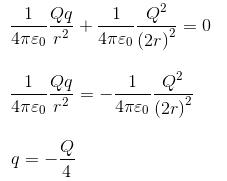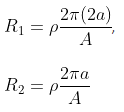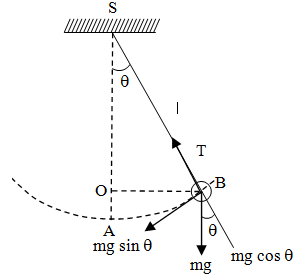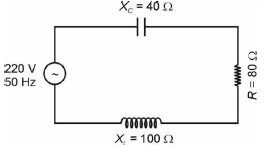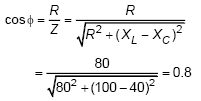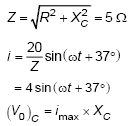NEET Practice Test - 8 - NEET MCQ
30 Questions MCQ Test - NEET Practice Test - 8
The velocity-time (v-t) graph for a moving object is shown in the figure. The total displacement of the object during the time interval when there is non-zero acceleration and retardation is


Read the assertion and reason carefully to mark the correct option out of the options given below:
Assertion : The velocity of flow of a liquid is smaller when pressure is larger and viceversa.
Reason : According to Bernoulli's theorem, for the stream line flow of an ideal liquid, the total energy per unit mass remains constant.
A projectile can have the same range 'R' for two angles of projection. If T1 and T2 are the time durations of flights in the two cases, the product of T1 and T2 will be directly proportional to
The ratio of the accelerations for a solid sphere (mass m and radius R) rolling down an incline of angle without slipping and slipping down the incline without rolling is
The radius of an air bubble at the bottom of a lake is 'r' and it becomes '2r' when the air bubble rises to the top surface of the lake. If 'P' cm of water is the atmospheric pressure, what is the depth of the lake?
Two identical charges (Q each) are separated by a certain distance. A third charge q is placed on the line joining the two charges, such that all the three charges are in equilibrium. What is the magnitude of the third charge?
Two circular coils 1 and 2 are made from the same wire, but the radius of the 1st coil is twice that of the 2nd coil. What is the ratio of potential differences applied across them, so that the magnetic field at their centres is the same?
A pendulum bob has a speed of 3 m/s at its lowest position. The pendulum is 0.5 m long. The speed of the bob, when length makes an angle of 60o to the vertical, is:
An eye specialist prescribes spectacles having a combination of a convex lens of focal length 40 cm in contact with a concave lens of focal length 25 cm. The power of this lens' combination is
If the input and output resistances in a common-base amplifier circuit are 400Ω and 400 kΩ, respectively, what is the collector current when the emitter current is 2 mA and current gain α is 0.98?
Which energy state of triply ionised beryllium (Be+++) has the same electron orbital radius as that of the ground state of hydrogen? Given Z for beryllium = 4.
Two masses m1 = 6 kg and m2 = 4 kg are connected by means of a string which passes over a frictionless pulley as shown in the figure.

When the masses are released, what is the acceleration of the masses? (Take g = 10 ms-2)
A body moving in a straight line with constant acceleration of 10 ms-2 covers a distance of 40 m in the 4th second. How much distance will it cover in the 6th second?
A tube, closed at one end containing air, produces, when excited, the fundamental note of frequency 512 Hz. If the tube is open at both ends, then the fundamental frequency that can be excited will be (in Hz)
Column-I gives certain physical terms associated with flow of current through a metallic conductor.
Column-II gives some mathematical relations involving electrical quantities.
Match Column-I and Column-II with appropriate relations.

Consider the following statements (A) and (B) and identify the correct answer.
A. A zener diode is connected in reverse bias when used as a voltage regulator.
B. The potential barrier of p-n junction lies between 0.2 V to 0.3 V.
A proton of mass m and charge +e is moving in a circular orbit in a magnetic field with energy 1 MeV. What should be the energy of an α - particle (mass 4m and charge +2e) so that it revolves in a circular orbit of the same radius in the same magnetic field?
The graph between magnetic susceptibility and absolute temperature for a paramagnetic substance is
At a certain place on earth, the true angle of dip is 60°, if the dip circle is oriented at an angle of 45º with the magnetic meridian, then the apparent angle of dip shown by the dip circle will be
A transformer with a power efficiency of 80% converts a 10 V primary input voltage (with a current of 10 A) to a voltage of 20 V. The current in the secondary coil will be
A Daniel cell is connected to the primary coil of a transformer. If the output voltage of the Daniel cell is 10 V, and the ratio of secondary to primary coil turns of transformer is 2, then the voltage in the secondary will be
The average value of current i = (4t2) A from t = 0 to t = 4 s is
An AC generator’s coil has 2000 turns and is rotated with angular speed of 500 rad/s. If the area of the coil is 10 cm2 and the magnetic field is 0.2 T, then the peak voltage in the coil will be
The impedance of the following circuit at very high frequencies of source voltage between A and B, will be

When 100 V DC is applied across a solenoid, a current of 1 A flows in it. When 100 V AC is applied across the same coil, the current drops to 0.5 A. If the frequency of the AC source is 50 Hz, the impedance and inductance of the inductor for the given AC circuit are
Consider the following two statements.
Statement-A: A hot wire ammeter reads the RMS value of current.
Statement-B: A hot wire ammeter can read AC but cannot read DC.
The correct statement(s) is/are
The ratio of respective capacitive reactance when connected with a source of frequency 40 Hz and 60 Hz is
The network shown in the figure is part of a complete circuit. If at a certain instant, the current i is 5 A and decreasing at a rate of 103 As−1 then potential difference between A and B (VB−VA ) is equal to 
An AC circuit having supply voltage V, consists of resistor of resistance 4 and capacitor of reactance 3 as shown in the figure. The voltage across the capacitor at time t = π / ωs is












